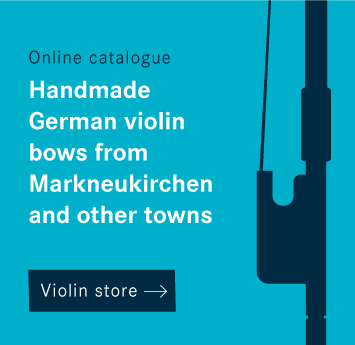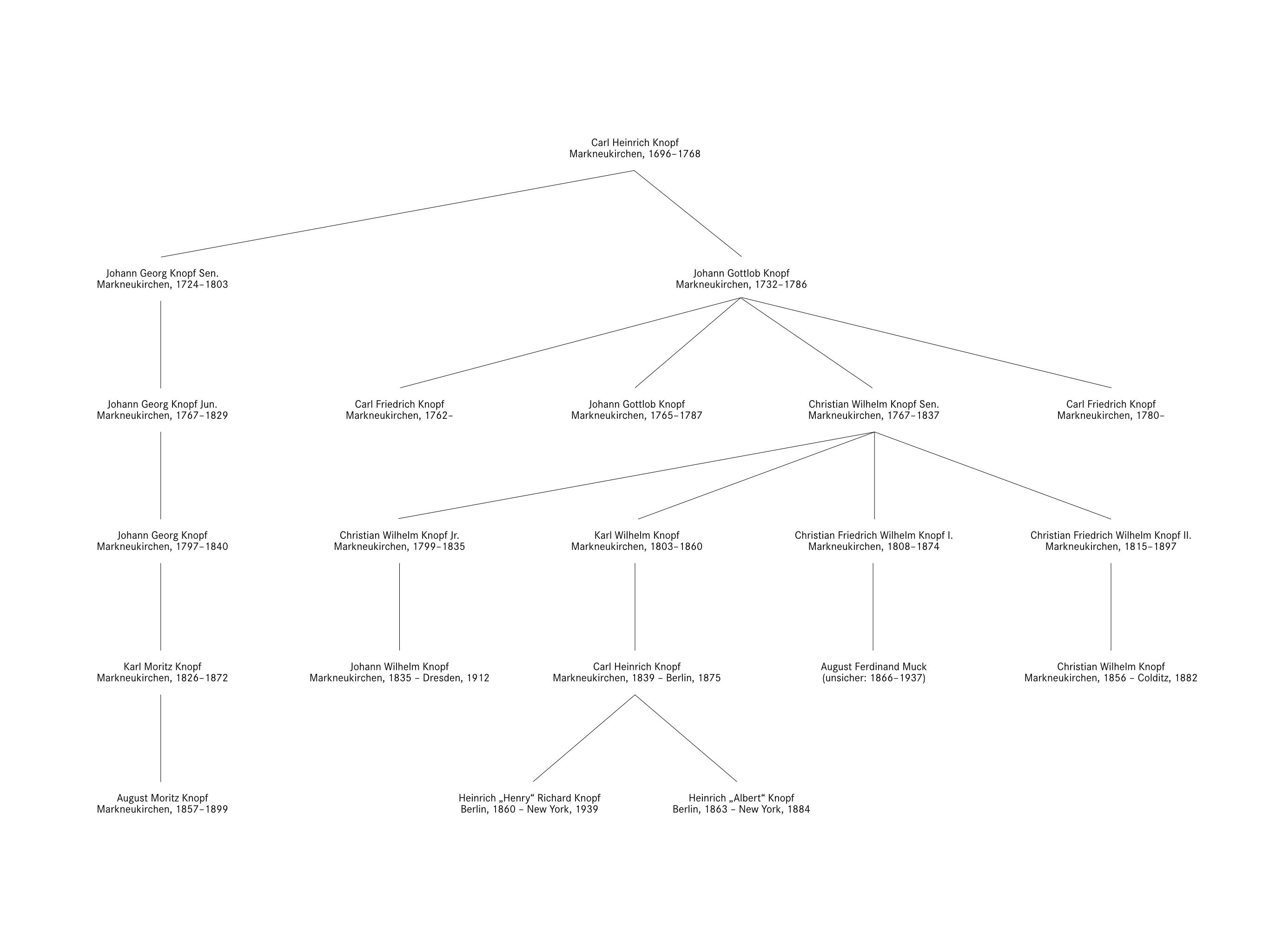The Knopf family of bow makers in Markneukirchen: a historical overview and notes on the lives and work of their most important masters.
The Knopf bow makers of Germany
- Christian Wilhelm Knopf (1767–1837)
- The origins of the Knopf family
- Christian Wilhelm Knopf as a bow maker
- The second generation of the Knopf bow maker family
- Outstanding masters of the third Knopf generation
- Johann Wilhelm Knopf (1835–1915)
- Carl Heinrich Knopf (1839–1875)
- Heinrich “Henry” Richard Knopf and the fourth generation of the Knopf family
- Side lines: Other members of the Knopf dynasty
- The “Herrmann Knopf Dynasty” – a genealogical addendum
Christian Wilhelm Knopf (1767–1837)
In 1767, the year Christian Wilhelm Knopf – the progenitor of the influential Knopf bow-making dynasty – was born, the region around his hometown of Markneukirchen was already in the midst of a historic boom that would transform the tranquil Bohemian-Saxon “music corner” into a global center of musical instrument making. This development also shaped Knopf's biography and is reflected in some of the detours this great personality of German craftsmanship had to take before finding his calling as a bow maker.
The origins of the Knopf family
At that time, his family had already been captivated by the economic appeal of the newly flourishing crafts and the business opportunities they offered for at least a generation:  While Knopf's ancestors were mainly tailors (and it is quite possible that the family name reflects a long-standing connection between his ancestors and this profession), by the middle of the 18th century the family had already turned to violin trading and string making, which also provided young Christian Wilhelm Knopf with part of his livelihood. However, the fact that such subcontracting work was not particularly lucrative is impressively demonstrated by his second profession as a soldier (musketeer), which he was still pursuing when he married in 1791. The inglorious end of his father, Johann Gottlob Knopf (1732–1786), also provides an insight into the social circumstances of the Knopf family at that time: After he fell to his death while drunk on his way home from the “Bierhauße,” the death register notes that he “had not led a good life” – an ambiguous phrase that casts a shadow over the beginnings of this illustrious family history.
While Knopf's ancestors were mainly tailors (and it is quite possible that the family name reflects a long-standing connection between his ancestors and this profession), by the middle of the 18th century the family had already turned to violin trading and string making, which also provided young Christian Wilhelm Knopf with part of his livelihood. However, the fact that such subcontracting work was not particularly lucrative is impressively demonstrated by his second profession as a soldier (musketeer), which he was still pursuing when he married in 1791. The inglorious end of his father, Johann Gottlob Knopf (1732–1786), also provides an insight into the social circumstances of the Knopf family at that time: After he fell to his death while drunk on his way home from the “Bierhauße,” the death register notes that he “had not led a good life” – an ambiguous phrase that casts a shadow over the beginnings of this illustrious family history.
Christian Wilhelm Knopf as a bow maker
It is not known whether Christian Wilhelm Knopf learned the bow-making trade from his father; although there are indications that he too had been involved in the construction of string bows, no works by him have survived and it is uncertain whether he could have trained his son in this art. Thus, it remains a mystery who Christian Wilhelm Knopf apprenticed with and what influences he absorbed – a regrettable gap in our knowledge, given the great significance of his work for German and European bow making. However, his work shows that he was inspired by John Dodd (1752–1839) and, even more so, by François Xavier Tourte (1747–1835), role models whom he quickly caught up with thanks to his remarkable talent. Celebrated by his contemporaries as the “German Tourte,” Christian Wilhelm Knopf has indeed had a lasting influence on the history of bow making: through innovations such as the metal frog track, improvements to the screw, his work, which is still in high demand today, and the inspiration and knowledge he passed on to posterity, not least through his four sons, who all followed in his craftsmanship.
The second generation of the Knopf bow-making family
Christian Wilhelm Knopf Jr. (1799–1835), Karl Wilhelm Knopf (1803–1860), Christian Friedrich Wilhelm Knopf I (1808–1874) and his younger brother of the same name, Christian Friedrich Wilhelm Knopf II (1815–1897), expanded the business established by their father and earned a good reputation with their work, which continued to be decisively inspired by Tourte and added a new and important branch to the increasingly diverse field of musical instrument making in Saxony. String bow making, which had been denied its own guild in Markneukirchen in 1790, rose to become a recognized craft, not least thanks to their efforts, with the best masters setting internationally acclaimed standards.

Family tree of the Knopf bow makers of Markneukirchen
Outstanding masters of the third Knopf generation
Johann Wilhelm Knopf (1835–1915)
By the middle of the 19th century, the Knopf family had long since left behind the tailoring trade, string making, and the hardships of earlier times. Trained by their fathers, the next generation matured in their well-established workshops, promising to set new artistic and business standards. Johann Wilhelm Knopf, a son of Karl Wilhelm Knopf, enjoyed an excellent reputation that almost eclipsed that of his grandfather. After opening his workshop in Dresden in 1884, he set milestones in German string bow making that bear the brand mark “W. KNOPF DRESDEN.”
Carl Heinrich Knopf (1839–1875)
The Knopf family's bow-making tradition reached another high point in the work of Carl Heinrich Knopf, another son of Karl Wilhelm Knopf, who, like his brother Johann Wilhelm, had been trained by his uncle Christian Friedrich Wilhelm Knopf II. His travels took him to none other than Ludwig Bausch in Leipzig, from where he returned to Markneukirchen in 1859. In 1860, following the death of his father, he took over the management of the Knopf workshop, which at that time supplied renowned customers including Richard Weichold in Dresden, Ludwig Bausch & Sohn in Leipzig, and even Charles Bruno in New York and Nikolai Kittel in Saint Petersburg.
Several awards at national and international competitions confirmed the excellent reputation of Carl Heinrich Knopf, who had long been considered one of the best masters of his art and who left behind works that are unparalleled to this day in terms of their musical qualities and magnificent craftsmanship. In 1868, he moved his workshop to Dresden and shortly thereafter to Berlin, where he worked until his untimely death at the age of almost 36. In addition to a large number of the finest bow sticks, approximately 30 violins made by his hand have also been preserved.
Heinrich “Henry” Richard Knopf and the fourth generation of the Knopf family
The sons of Carl Heinrich Knopf – Albert Knopf (1863–1884) and Heinrich “Henry” Richard Knopf (1860–1939) – did not remain in Germany after their father's death and moved to the USA. Both were talented craftsmen who turned their attention to bow making and violin making. They received an excellent education, first following family tradition and learning from their father and his brothers, then Henry perfecting his art with Otto Bausch in Leipzig and G. Christian Adam, Oswald Möckels' teacher in Berlin. After 1880, both moved to New York, where Adam died of tuberculosis just four years later. Heinrich “Henry” Richard Knopf became one of the first violin makers in New York City and established himself extremely successfully in the circle of the Metropolitan Opera Orchestra. Approximately 450 string instruments and 1,000 bows have been preserved from his highly productive hand, the latter bearing the brand mark “H. R. KNOPF.NEW YORK.” His later work in bow making reveals the strong influence of Eugène Sartory, whose first representative in the US he became, and was in high demand among the leading soloists of his time.
With the Great Depression, business conditions deteriorated even for such a well-known workshop, and in 1929 Heinrich “Henry” Richard Knopf decided to end the history of the Knopf family of bow makers after more than 100 years. He sold his workshop to Rembert Wurlitzer; his two sons took up other professions.
Side lines: Other members of the Knopf dynasty
Like Albert and Heinrich “Henry” Knopf, other members of the fourth generation of the Knopf family and other branches of the family completed their training in the family workshops of their fathers and uncles, where they developed into successful masters of both violin and bow making:
- Christian Wilhelm Knopf (1856–1882) was a bow maker; the son of Christian Friedrich Wilhelm Knopf II suffered a tragic fate and spent most of his life in an institution for the mentally ill.
- August Ferdinand Muck (1866–1937), a son of Christian Friedrich Wilhelm Knopf II, learned bow making from his father's brother of the same name.
- August Moritz Knopf (1857–1899) came from another branch of the family, which traced its roots back to Johann Georg Knopf Jr. (1767–1829), a brother of Christian Wilhelm Knopf. He was one of the most important members of the family, working in Dresden for Richard Weichold, Louis Lowenthal, and Julius H. Zimmermann in Moscow.
The “Herrmann Knopf Dynasty” – a genealogical addendum
Although the history of the Knopf dynasty ended in 1929 with the closure of Heinrich “Henry” Richard Knopf's business, there is still a link between this important chapter in music history and the present day. The marriage of Carolina Wilhelmine Knopf (1832–1917) to Christian Friedrich Herrmann (1819–96) created a link between these two great bow-making families from Markneukirchen – whose legacy lives on today in the workshop of Michael Mönnig, a great-great-grandson of the couple, and his son Thomas Mönning.
Originally published by Corilon violins.




